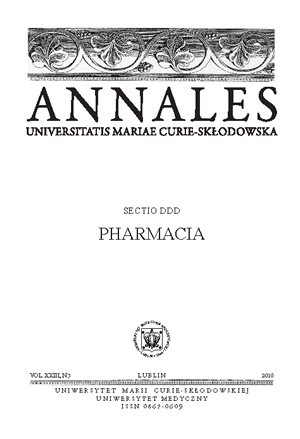The evaluation of some macroelement levels in selected dietary supplements supporting immune system of the human organism
Keywords:
dietary supplements, calcium, magnesium, flame atomic absorption spectrometer (FAAS)Abstract
Dietary supplements enjoy great popularity among consumers in Poland - it is possible to apply them prophylactically or as supplements in therapy of different disease entities. Preparations taken with an aim to increase body's resistance constitute the important group of supplements. Plant raw materials included in the studied supplements contain active substances which biologically reveal general strengthening action, restore physical fitness and intellectually stimulate the organism and improve properties of the immunological system. Powdered herbalist's raw materials composing these preparations can frequently abound in significant amounts of mineral substances. Due to the scarcity of academic publications connected with mineral composition of this type of preparations and their frequent application, examining calcium content and of magnesium (of the micronutrients important for the human body), appeared to be substantiated.
The subject of the research were the supplements in the form of capsules and tablets: (Acerola Plus, Cat’s Claw, Maca, Maca 50 Plus, Spirulina, Spirulina Hawajska, Spirulina Pacifica, Vilcacora, Żeń-szeń from „Herbapol” Herbal Plant in Krakow, Żeń-szeń – Ginseng (KRKA), Żeń-szeń (Naturell), Żeń-szeń koreański (Walmark), Żeń-szeń (vita-complex) and fluid preparations: (Aloes - aloe juice;, Aloe vera drinking gel, Aloes- aloe juice with pulp pieces, Aloes Activ, Aloes Young, Bodymax Tonik, Ginsengin 400, Ginsenol, Noni, Noni-vita, Noni Plus. Samples of supplements were mineralized “dry” at the temp. of 450˚C. Calcium and magnesium contents were determined in the of the atomic absorption spectrometer SOLAAR M 5 (Thermo Elemental).
The smallest levels of calcium and magnesium were noted in the liquid preparations: of calcium from 0.81 μg.ml-1 (Ginsenol) and 1.36 μg.ml-1 (Activ Aloe) to 250.9 μg.ml-1 (Aloe Vera drinking gel) and of magnesium from 2.27 μg.ml-1 (Aloe Activ) to 153.7 μg.ml-1 (Noni-vita). In supplements in the form of capsules and tablets, calcium content ranged from 45.92 μg.g-1 (Acerola Plus) to over 20 000 μg.g-1 (Maca, Maca 50 Plus) and of magnesium from 513 μg.g-1 (Maca 50 Plus) and 517 μg.g-1 (Maca) to 4043 μg.g-1 (Żeń-szeń - vita-complex).
Calcium and magnesium contents in the studied dietary supplements were diversified - depending on pharmaceutical form of preparation and the composition. Stated quantities of mentioned macroelements can fill up daily demand of the organism for calcium and magnesium in the course of their application.
References
1. Błoniarz J., Zaręba S., Rahnama M.: The levels of calcium and magnesium In dietary supplements. W: red. K. Pasternak Pierwiastki, środowisko i życie człowieka, Wydawnictwo „System-Graf”, Lublin 2009.
2. Błoniarz J., Zaręba S., Rahnama M.: The study of calcium and magnesium levels in dietary supplements containing antioxidants available in the Polish market. Annales UMCS, sect. DDD, 22, 171, 2009.
3. Dybczyński R. et al.: Preparation and Certification of the Polish Reference Material „Mixed Polish Herbs” (INST-MPH-2) for inorganic Trace Analysis, Raporty IChTJ, Seria A nr 4/2002, Institute of Nuclear Chemistry and Technology, Warszawa 2002.
4. Elless M.P. et al.: Plants as a natural source of concentrated mineral nutritional supplements. Food Chem., 71, 181, 2000.
5. Gonzales G.F., Valerio L.G.: Medical plants from Peru: A review of plants as potential agents against cancer. Anti-Cancer Med. Chem., 6, 429, 2006.
6. Jarosz M., Bułhak-Jachymczyk B.: Normy żywienia człowieka. PZWL, Warszawa 2008.
7. Kim M.-H. et al.: Immunomodulatory activity of Ginsan, a polysaccharide of Panax ginseng, on dendritic cells. Korean J. Physiol. Pharmacol., 13, 169, 2009.
8. Krejčová A. et al.: Determination of macro and trace element in multivitamins preparations by inductively coupled plasma optical emission spectrometry with slurry sample introduction. Food Chem., 98, 171, 2006.
9. Leśniewicz A., Jaworska K., Żyrnicki W.: Macro- and micro-nutrients and their bioavailability in polish herbal medicaments. Food Chem., 2006, 99, 670-679.
10. Moyad M.A.: The potential benefits of dietary and/or supplemental calcium and vitamin D. Urologic Oncology, 21, 384, 2003.
11. Park J.D., Rhee D.K., Lee Y.H.: Biological activities and chemistry of saponins from Panax ginseng C.A. Meyer. Phytochem. Rev., 4, 159, 2005.
12. Pietruszka B., Brzozowska A.: Witamin and mineral supplement use among adults in central and eastern Poland. Nutr. Res., 1999, 19, 817-823.
13. Pinta M.: Absorpcyjna spektrometria atomowa. Zastosowanie w analizie chemicznej. PWN, Warszawa 1977.
14. Power M. L. et al.: The role of calcium in health and disease. Am. J. Obstet. Gynecol., 181, 1560, 1999.
15. Reiss R.I.N. et al.: Immunomodulating and antiviral activities of Uncaria tomentosa on human monocytes infected with dengue virus-2. International Immunopharmacology, 8, 468, 2008.
16. Swaminathan R.: Magnesium metabolizm and its disorders. Clin. Biochem.Rev., 24, 47, 2003.
17. Vormann J.: Magnesium: nutrition and metabolizm. Molecular Aspect Med., 24, 27, 2003.
18. Ziemlański Ś.: Normy żywienia człowieka. Fizjologiczne podstawy. PZWL, Warszawa 2001.
Downloads
Published
Issue
Section
License
Copyright (c) 2010 Authors

This work is licensed under a Creative Commons Attribution-NonCommercial-NoDerivatives 3.0 Unported License.


